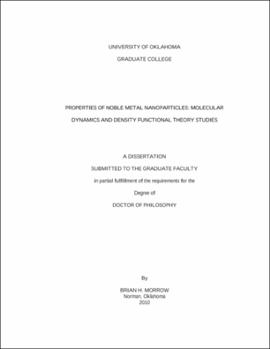| dc.description.abstract | Supported metal nanoparticles play an important role in heterogeneous catalysis. In recent years, carbon nanotubes, because of their unique properties, have drawn interest as supports. The structural and dynamic properties of the supported metal nanoparticles can have a large effect on their catalytic properties. Towards understanding how the geometry of the support affects the properties of the metal nanoparticles, we performed molecular dynamics simulations of platinum and platinum- gold nanoparticles on graphite and bundles of carbon nanotubes of various diameters. Our results indicate that diffusion of the nanoparticle center of mass is one order of magnitude slower for Pt nanoparticles supported by carbon nanotube bundles than for Pt nanoparticles supported by graphite. Density profiles, radial distribution functions, and coordination numbers were used to characterize the morphology of the Pt nanoparticles. We found that carbon nanotube-supported nanoparticles exhibit a more disordered structure than graphite-supported nanoparticles. Simulations of nanoparticles containing 130, 249, and 498 atoms were conducted to assess how nanoparticle size affects nanoparticle morphology and mobility. It was found that increasing the nanoparticle size decreased its diffusion coefficient and increased its melting temperature. The size of the nanoparticle appears to affect the nanoparticle structure less than the geometry of the support. The effect of the metal-carbon interaction strength on the structure of the supported nanoparticles was studied, and our results indicated that there are not dramatic differences in the nanoparticle structure when different interaction parameters are used. Bimetallic Pt-Au nanoparticles were simulated in an effort to determine how the support and nanoparticle composition affect the distribution of atoms within and on the surface of the nanoparticles. We found that, regardless of the support, Au atoms tended to segregate to the exterior of the nanoparticles. However, different supports lead to different arrangements of surface atoms in the nanoparticle, which has an effect on the nanoparticles catalytic activity. We also performed density functional theory calculations for CO adsorption on 13-atom Pt-Au clusters. We found that changing the environment around the metal atom on which CO adsorbs changes the adsorption energy and C-O vibrational frequency. Electronic structure properties of the clusters, such as charges on relevant atoms and densities of states, were discussed to explain the observed results. | |
